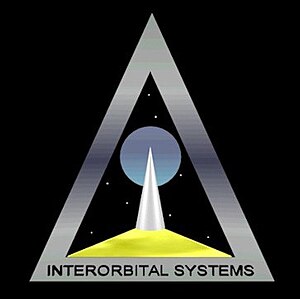Interorbital Systems
 |
|
| Industry | Aerospace |
|---|---|
| Founded | 1996 |
| Headquarters | Mojave, California |
|
Key people
|
Rod Milliron and Randa Milliron (founders) |
| Products | Orbital rocket launch Commercial Orbital Transportation Services |
| Website | http://www.interorbital.com/ |
Interorbital Systems Corporation (IOS) is an American aerospace manufacturer active in Mojave, California. It was founded in 1996 by Roderick and Randa Milliron, who also co-founded Trans Lunar Research, a non-profit organization. They aim to develop simple, yet robust technology to be the lowest-cost launch provider in the commercial space industry.
Interorbital Systems is currently engaged in building a launch vehicle for the Google Lunar X Prize Team Synergy Moon and for commercial launches. The company was also a competitor in the Ansari X Prize and America's Space Prize.
Both kits are launched into 310 km (192 mi) self-decaying orbits where they will eventually burn up in the Earth's atmosphere. Currently, they have a large launch manifest for both kinds of launches.
Interorbital Systems is currently engaged as a member of and launch provider for Team Synergy Moon in the Google Lunar X Prize competition. The team's lunar rover will be lifted to the Moon's surface by a modified, 36-module version of the NEPTUNE rocket.
Interorbital Systems current development focus is on its NEPTUNE line of launch vehicles.
All of Interorbital's rocket designs are based on the Common Propulsion Module (CPM). The CPM is a small, self-contained rocket system capable of delivering a 145 kg payload to an altitude of 310 km. Multiple CPMs are combined through parallel staging to meet varying mission requirements. Though they have experimented with cryogenic fuel, Interorbital currently uses hypergolic white fuming nitric acid and Turpentine for oxidizer and fuel. The CPM is designed to maximize simplicity - it uses no turbopumps and no ignition system (because of the hypergolic propellants).
The NEPTUNE system is Interorbital System's flagship line of launch vehicles built from varying configurations of the Common Propulsion Module.
There are currently four stable configurations:
...
Wikipedia
